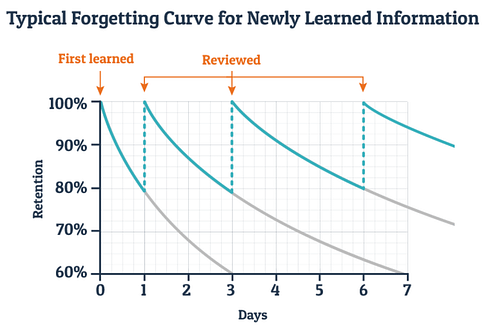
Learning new things is always interesting but consistently recalling your newfound knowledge when you need it most is something humans have been trying to hack for all of history. Unless blessed with a photographic memory, most of us could use some tricks to learn more effectively.
In this post, I’ll talk about knowledge gaps and learning techniques for improved information retention and understanding.
The illusion of competence
Richard Feynman, the Nobel Prize-winning physicist, said that there are two types of knowledge. There is knowing something and there is knowing the name of something.
Many times we focus on being able to recall headlines or surface-level facts but fail to grasp the essence of what we’re talking about. We see this constantly in adults, who use technical jargon or fancy words to try and mask the limits of their knowledge while passing off their report as profound understanding.
“The person who says he knows what he thinks but cannot express it usually does not know what he thinks.”
Mortimer Adler
So, how can we not just sound like we know what we’re talking about but actually know what we’re talking about? The best way to identify gaps in our knowledge is by using the Feynman technique (developed by the aforementioned physicist).
The Feynman Technique
This technique states that to test your understanding of a topic you should try and explain it as simply as possible, as if to a child. If you struggle or start adding a lot of fluff it’s an indication that your understanding is incomplete.
The four steps to the Feynman technique are as follows:
- Choose a concept you want to learn about.
- Explain it to yourself as if you were teaching a 10-year-old (or if you find a willing participant, teach it to them).
- Identify the parts that you struggle to explain simply.
- Go back and revise these parts and repeat until you understand the topic to your satisfaction.
Once you have the core understanding by all means get more technical if that’s what is required. But just remember, knowing the name of something is not the same as knowing it. This is illustrated in this video where Dr Talia Gershon from IBM explains quantum computing to people with varying degrees of knowledge (it’s also a fascinating topic).
Learning more effectively
The Feynman technique helps to identify when your understanding is incomplete, but how do you combat this and learn effectively? Below are some key tips.
Spaced repetition
When we first learn something a neural connection is created in our mind, storing that piece of information. This connection weakens over time unless constantly reinforced as shown by the forgetting curve, developed by Hermann Ebbinghaus in the 19th century.
We see that the best way to combat forgetting is through repeated engagement with the material over a period of time – cramming won’t work! By revisiting the information at spaced intervals we can strengthen the neural connection and improve retention.

The key thing is that you use active recall when revisiting information. This means trying to recall information without looking at your notes, which is a more effective learning method than just passively highlighting or reading. Wait till you see the results!
Sleep
Toxins build up in our brain while we’re awake. These toxins hinder our cognitive performance, making it harder to think and recall information. During sleep, the mind flushes out these toxins and sifts through learnt information, strengthening the relevant neural connections.
To improve your memory, clarity of thinking, and so many other aspects of your life, getting a good nights rest is vital. Read about the life-changing benefits of sleep here.
Learn by doing
While reading is a great joy and a solid method to absorb ideas, engaging with information in different ways gives our brain a chance to create more associations. An excellent way to actively engage with a topic is by talking about it with experts or even others who are knowledgeable and interested. This is related to the Feynman technique – if you can explain it you can understand it.
Exercise
Not only does exercise keep you physically healthy but it is vital to supporting your memory as it builds neurons. When you exercise your focus is elsewhere giving your subconscious a chance to sort through information in the background.
Many studies suggest that parts of the brain controlling thinking and memory are bigger in people that exercise than those that don’t. While unclear what types of exercise are best, it’s safe to assume that maintaining an active lifestyle will yield memory improvements.
Chunking
Ever wonder why it’s difficult to remember lists of any kind? According to Miller’s Law it’s because the average person’s short term memory can only hold 7 pieces of information at a time.
Before we resign ourselves never trying to memorise anything again there is a caveat. The 7 pieces of information can be as big as we want. This can be leveraged by using a technique called ‘chunking’.
Chunking is when we group information using acronyms, metaphors, analogies, stories, mnemonics etc. It’s a lot harder to remember the colours of the rainbow outright but using the classic ‘Richard Of York Gave Battle In Vain’ creates an easy visual in our mind. The best bit is that, according to Miller, this only counts as one ‘chunk’. You have six more to go!
So, next time you read an interesting headline or fact that you want to share later, chunk it to maximise your 7 list limit. Make it visual, make it silly, and make it memorable.
These are a mix of tools and techniques to learn anything effectively. You can now identify when you don’t fully grasp a concept and how to package information for better retention. Go forth and learn!


